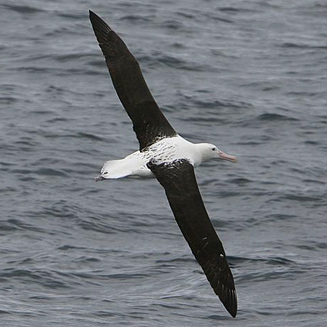|
Diomedea sanfordi (Northern
royal albatross)
Swartvlerkkoningalbatros [Afrikaans];
Swartvlerkkoningmalmok [Afrikaans]; Albatros royal du Nord [French]
Life
> Eukaryotes >
Opisthokonta
> Metazoa (animals) >
Bilateria >
Deuterostomia > Chordata >
Craniata > Vertebrata (vertebrates) > Gnathostomata (jawed
vertebrates) > Teleostomi (teleost fish) > Osteichthyes (bony fish) > Class:
Sarcopterygii (lobe-finned
fish) > Stegocephalia (terrestrial
vertebrates) > Tetrapoda
(four-legged vertebrates) > Reptiliomorpha > Amniota >
Reptilia (reptiles) >
Romeriida > Diapsida > Archosauromorpha > Archosauria >
Dinosauria
(dinosaurs) > Saurischia > Theropoda (bipedal predatory dinosaurs) >
Coelurosauria > Maniraptora > Aves
(birds) > Order: Ciconiiformes
> Family: Diomedeidae
 |
 |
| Northern royal albatross, offshore
from Cape Town, South Africa. [photo
Trevor Hardaker ©] |
Northern royal albatross, offshore from Cape
Town, South Africa. [photo Trevor Hardaker ©] |
Distribution and habitat
Breeds on islands off the coast of New Zealand, dispersing
in the non-breeding season to the waters surrounding South America. It is
generally scarce in southern African waters, while most common over the
continental shelf edge between the Orange River, Northern Cape and Cape Agulhas,
Western Cape but also rarely occurring further south.
Movements and migrations
Arrives at its breeding colonies in October,
breeding before dispersing about a year later across the southern
oceans.
Food
The following food items have been recorded
in its diet:
- squid
- Moroteuthopsis ingens
- Histioteuthis atlantica
- fish
- crustaceans
- tunicates
- scavenged penguin carcasses
Breeding
Breeds in dense colonies on small rocky islets (Chatham
Island) or vegetated slopes (Taiaroa Head), laying its eggs in late October and
November. The chicks hatch in the period from January-February, fledging in
September and October.
Threats
Endangered, due to low breeding success at Chatham
Island, New Zealand, largely as a result of a severe storms in 1985 which washed
away vegetation and soil, forcing birds to breed on bare rock or build nests of
stone. This causes egg breakage, high egg temperatures and nest flooding. It
also has a colony at Taiaroa Head, New Zealand, where it has been negatively
impacted by blowflies and introduced predators, however intensive conservation
work have thankfully enhanced the breeding success of birds there.
References
-
Hockey PAR, Dean WRJ and Ryan PG 2005. Roberts
- Birds of southern Africa, VIIth ed. The Trustees of the John Voelcker
Bird Book Fund, Cape Town.
|
